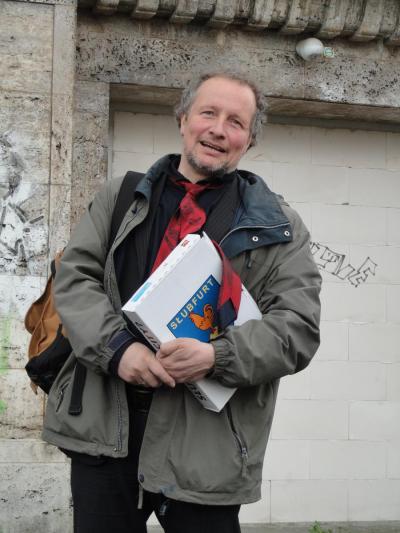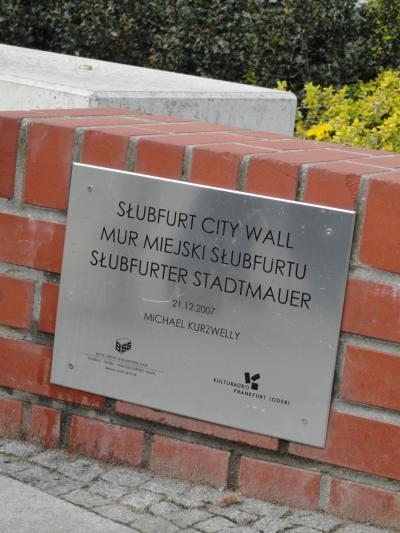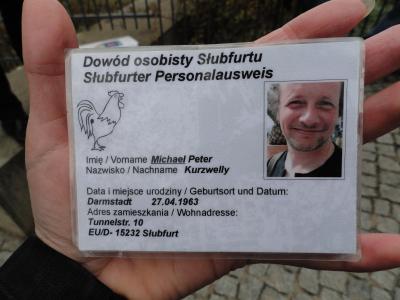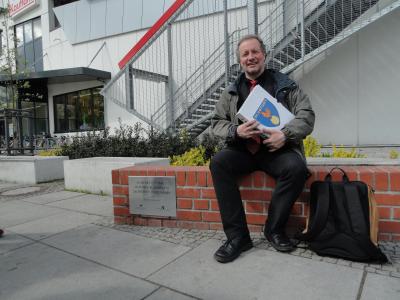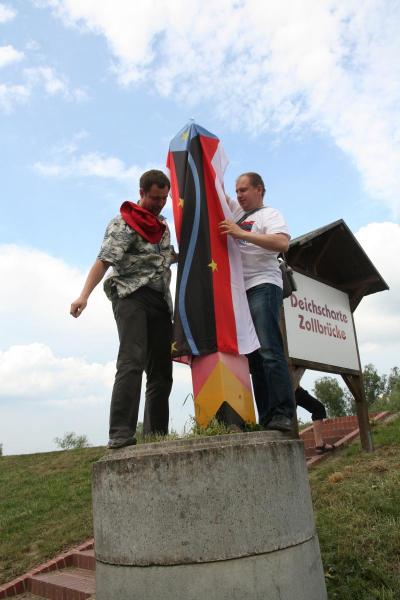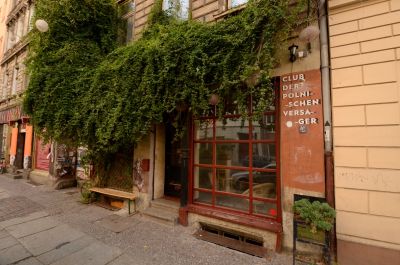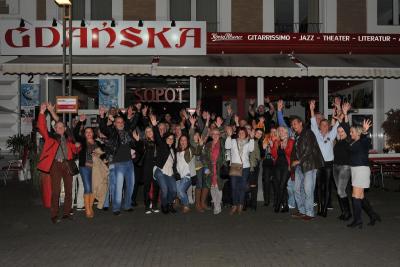Słubfurt and Nowa Amerika
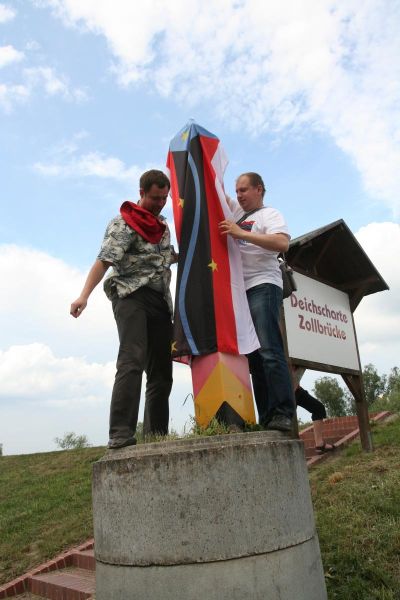
“Szanowni Damen und Panowie, herzlich witamy in Słubfurt, einer Stadt, które liegt auf polskiej und deutscher stronie”. These are the words used by the artist and tourist guide, Michael Kurzwelly, to welcome visitors to a guided tour of Frankfurt (Oder) and Słubice. The faces of the guests express amazement and curiosity, so Kurzwelly explains: “Słubfurt is the first town that is half in Germany and half in Poland. Its name is derived from Słubice (Słub) and Frankfurt (Furt).”
Słubfurt was founded in 1999 and registered as an organisation one year later. “Słubfurtisch” is a language created from elements of German and Polish. In 2008, the Council of the imaginary town adopted an 84-point constitution to regulate the functioning of the community.
The art project soon turned into an initiative that provided residents on both sides of the Oder with opportunities to get to know each other better. The task was all the more difficult because the border had been closed for a long time and stereotypes were still alive in both countries. Selective actions were taken to overcome mutual suspicions: one of these was the “Bon Appetit – Smacznego” campaign in 2000, when 16 families from Słubice and Frankfurt invited German and Polish guests to eat with them. As a result, new friendships began.
The Słubfurt Olympic Games in 2003 was another memorable event. They took place on the Brückenplatz in Frankfurt, not far from the border bridge between the German river bank and the Polish town of Słubice. The Olympic programme was put together by Słubfurter with their own sense of humour. The most popular discipline was the “Tossing packs of cigarettes” across the border. The games took place once more in 2016. They featured mixed German-Polish teams that came together by drawing lots.
In 2009, posters publicising previously unknown political parties were put up on the streets of Słubfurt as part of an art project aimed at mobilising the citizens of both towns to conceive a united future. A fictitious German-Polish parliament stood for election, and this eventually became a platform for implementing common ideas. It was also an important voice in the debates held by the real councils in Słubice and Frankfurt. In 2011, the Słubfurt “local elections” received the award of the Brandenburg State Agency for Civic Education for promoting political participation among people in the border region.
Słubfurt is also a network of contacts that makes everyday life easier for people in the border region. One of these is the so-called “Repair Café”, in which old and defective objects are made ready for use again. Here the inhabitants of both towns carry out the repairs themselves. '”ZeitBankCzasu” also offers a free exchange of mutual services, where anyone can exchange their time and skills for someone else's time and skills. This idea has resulted in reciprocal courses in Polish and German, translations of certificates, and jogging groups on both sides of the Oder. In May 2012 the Internet radio Słubfurt, which is operated by radio fans, also went on air. The station offers interviews, announces local events and broadcasts reports several times a month.
The success of Słubfurt prompted German and Polish artists in March 2010 to go one step further and extend the project of the imaginary town to include the whole borderland. Thus, along the Oder and the Neisse river another art project entitled “Nowa Amerika” [New America] was born. Now, however, it not only included the inhabitants of a single town, like Słubfurt, but almost the entire border region from Gubin [Guben] to Szczecin [Stettin]. “Nova America” consists of four “states”: “Lebuser Ziemia”, “Schlonsk” in Silesia, “Terra Incognita” in the Chojna area and “Szczettistan” in the Szczecin area, covering the territories of all the states on the German and Polish sides of the border.
Even though the project is an artistic creation, “Nowa America” has its roots in reality. On the one hand Frederick the Great (1712-1786), the King of Prussia, was partly responsible for the partition of Poland, a fact that the founders of “Nowa Amerika” clearly disapproved of. On the other hand, he succeeded in acquiring new lands like the “Oderbruch” without waging war. It is less well known that Frederick the Great commissioned the drainage of the swamps and moors on the lower course of the Warta. This is how the area known as the “Warthebruch” came into being. The impetus for these measures came from a visit from a delegation of farmers who asked the King for permission to emigrate to America, where they had been promised free land. At home, their areas were repeatedly hit by floods and this had rendered them unusable.[1]
It is said that Frederick the Great told the farmers that he would create a local America for them, a promise which he kept. The drained land was soon settled by peasants to whom the ruler gave houses and arable land and waived taxes. Among them there were many Poles, since the Prussian population had been decimated in the course of many wars.[2] There were also Dutch citizens who knew how to drain swamps better than anyone else.
[1] Beata Bielecka, Obrazki jak z dzikiego zachodu w naszej Ameryce nad Odrą, [in:] Gazeta Lubuska, 21.08.2014, online: http://www.gazetalubuska.pl/wiadomosci/slubice/art/7459547,obrazki-jak-z-dzikiego-zachodu-w-naszej-ameryce-nad-odra,id,t.html
[2] Ibid.
To live up to the myth of the early days, the country was called “New America”. The villages and colonies were given exotic names: New Hampshire, Neu Yorck, Florida, Maryland, Jamaica and Sumatra. Today these names can no longer be found on any map. After the World War II, the village of Savannah was renamed Czubkowo, the Pennsylvania colony was named Polne, Hampshire became Budzigniew, Jamaica Jamno, Quebeck Boguradz and Florida Sadowice.[3] Only the village of Malta (in the district of Sulęcin, Lebus county), was spared from changing its name. Hence it still commemorates the unusual history of colonisation in the 18th century.
As far as the creators of Nowa America are concerned: “This unusual story has inspired us to call our new territory connecting the (...) borderland, 'Nowa America', a land of pioneers and people hungry for freedom who want to create a new civil society together and who recognize that this is our Promised Land”.[4]
In 2015, the term “Promised Land” became particularly important. When a wave of refugees came to Germany that year, many them arrived in places close to the border. Increasing prejudices against “new” and “foreign” arrivals became noticeable on both sides of the border, so that the artists began to regard social mistrust as a challenge. Projects were set up to help the refugees find their way into their new reality and to help the local inhabitants to get used to their new neighbours. There were several meetings with refugees under the title “What kind of people are these?” (“Co to za jedni?”). These familiarized local young people with the living conditions, the fates and the origin of the migrants. In a workshop entitled “We are all migrants” (“Wszyscy jesteśmy migrantami”), a group from the village of Boruja Kościelna discussed the reasons for border shifts and migration in the region. Similar events were organised for the refugees who got to know the Sorbian culture in Bautzen, among others.
One thing is particularly important to the “Nowa-Americans”: to improve the bad image of the border region. “Everyone is complaining how bad things are here and that there are no prospects,” says Andrzej Łazowski, a photographer and co-founder of “Nowa Amerika”. “The Germans go to West Germany and the Poles move to larger cities or abroad. Our activities aim to show that the German-Polish border region is a great place for creative people. All you have to do is to stop moaning.”
Monika Stefanek, February 2018
Słubfurt online: www.slubfurt.net
Nowa Amerika online: nowa-amerika.eu
[3] The article is online at: http://szukajwarchiwach.pl/66/125/0/str/1/15#tabZespol
[4] Internet: www.slubfurt.net
